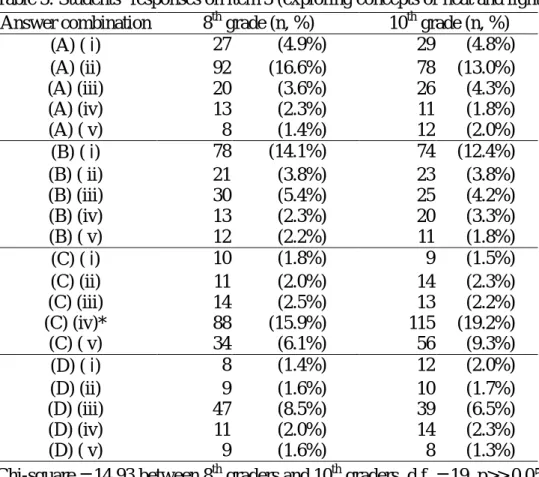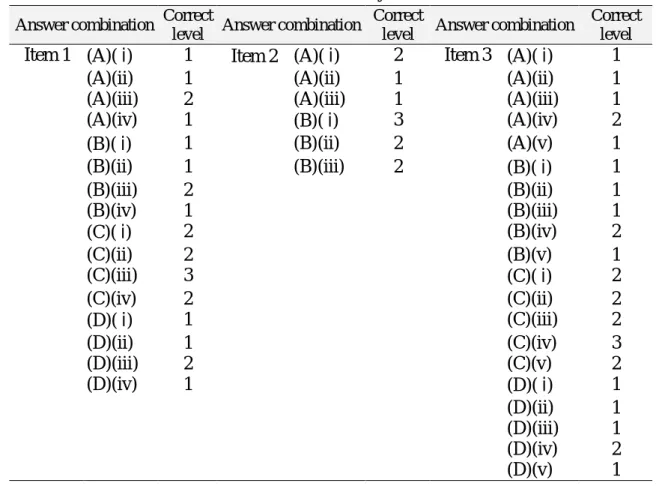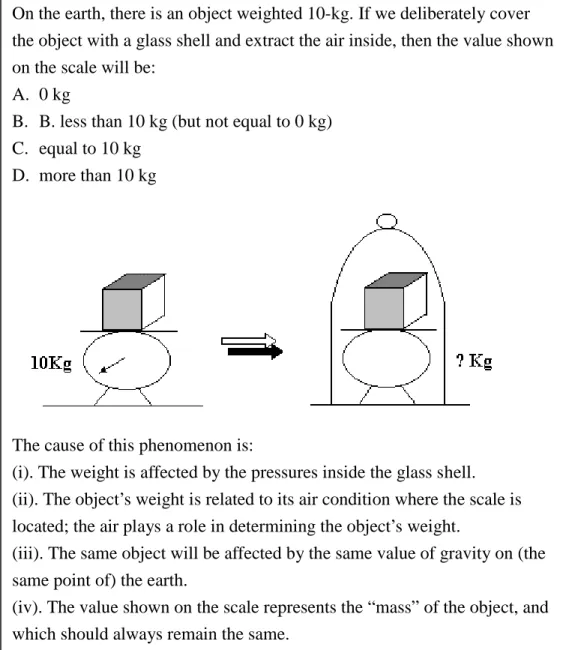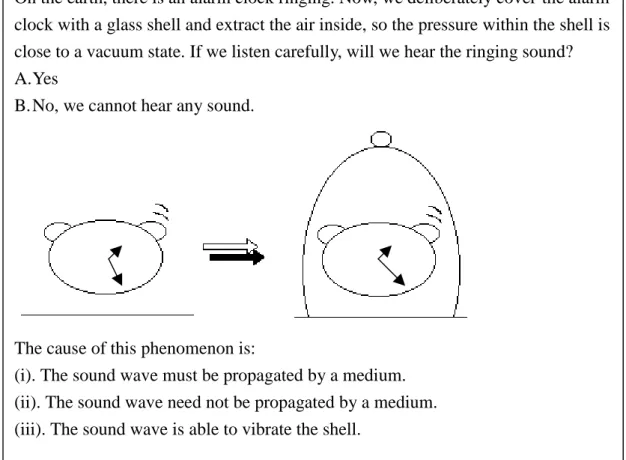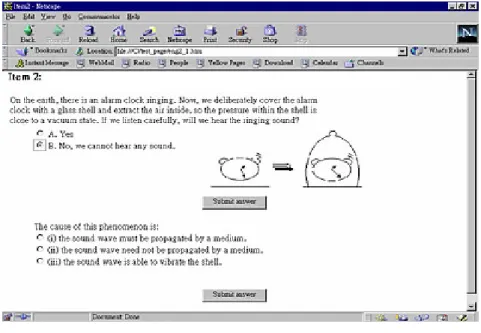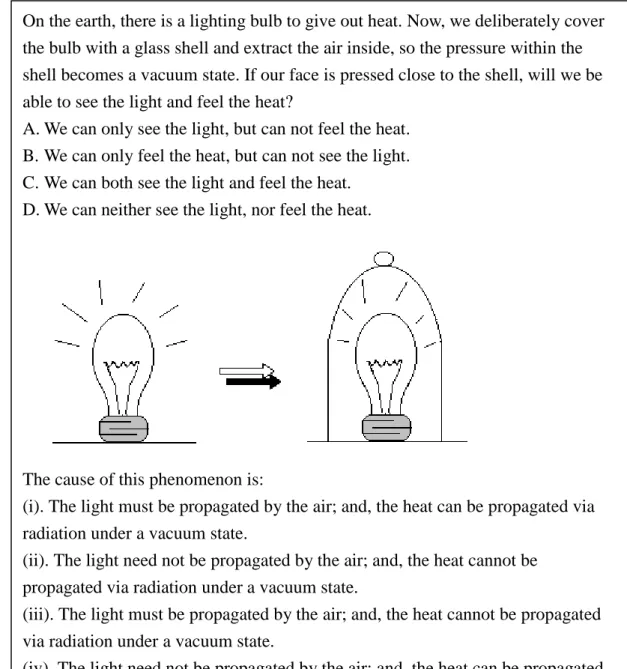計畫編號:NSC89-2511-S-009-027-執行期限:2000/08/01∼2001/07/31
主持人:蔡今中
執行機構:國立交通大學教育學程中心
Abstr act
This study described an attempt to develop a networked two-tier test system. A two-tier test is a two-level multiple-choice question that diagnoses students’ alternative conceptions in science. Three networked, two-tier test items were presented in this study. Five hundred fifty-five 8th graders and five hundred ninety-nine 10th graders in Taiwan were asked to answer these items on-line. An analysis of students’ answers suggested that students’ alternative conceptions might be retained even after formal instruction about relevant conceptions. Moreover, their responses were related across these three two-tier test items. Further development of the two-tier test system will mainly focus on designing appropriate feedback and guidance that help students overcome their alternative conceptions. In this way, the networked two-tier test system is not only a diagnostic tool, but also an effective instructional tool. This study has illuminated some innovative thoughts for the research and practice of science education.
Keywor ds: two-tier test, science education, testing, quantitative, Internet
Introduction
In recent 25 years, many science educators believe that students’ knowledge in domain-specific areas plays a more important role than their general cognitive ability
or underlying logical structures on conceptual learning of science (Driver and Easley, 1978). Consequently, science education researchers have widely surveyed students’ knowledge in various domains, known as students’ “misconceptions” or “alternative conceptions” (Wandersee, Mintzes and Novak, 1994). This research trend facilitates the practice of constructivism in the field of science education since it is important to know what prior knowledge students bring to a learning environment to properly help them construct new knowledge (Tsai, 1998a, 2000a, 2000b). Researchers have developed methods to explore student alternative conceptions, for instance, interviews (Bell, 1995; Posner and Gertzog, 1982) and concept maps (Novak and Gowin, 1984). However, these methods often require additional training and commitments of time to conduct, analyze, and to make interpretations (Ruiz-Primo and Shavelson, 1996). A two-tier test, a pencil and paper test in a multiple-choice format, hence, is proposed by science educators to diagnose students’ alternative conceptions (Treagust, 1988; Odom and Barrow, 1995). Two-tier tests are explained more fully below. The use of two-tier tests allows teachers to not only understand students’ scientifically
incorrect ideas, but also to explore students’ reasoning behind these ideas. Moreover, it facilitates assessment of alternative conceptions of a larger sample of students in a more efficient and relatively straightforward manner, and has been widely used in science education research (Christianson and Fisher, 1999; Voska and Heikkinen, 2000).
With rapid development of Internet technology, the two-tier test can be implemented on a web site to further achieve wider accessibility for students and practicing teachers. This paper describes an attempt to develop a networked two-tier test system.
The two-tier test is a two-level question presented in a multiple-choice format. The item presented in Figure 1 shows a sample that explores students’ alternative conceptions about weight. The first tier assesses students’ descriptive knowledge about the phenomenon, that is, the weight in a vacuum condition on the earth. The second tier explores students’ reasons for their choice made in the first tier. Hence, the second tier investigates students’ explanatory knowledge or their “mental
models.” Since the two-tier test is in a multiple-choice format, it is much easier for teachers to score or interpret students’ responses. In this way, even with numerous students, a teacher can efficiently diagnose their alternative conceptions.
(Insert Figure 1 about here)
Treagust (1988) has proposed that to develop appropriate two-tier tests to diagnose students’ alternative conceptions, researchers should examine related literature to improve the quality of the tests in light of current research findings, and conduct unstructured student interviews to better understand in-depth how the
students are reasoning. Hence, the two-tier test items used in this study mainly drew upon related research literature (e.g., Minstrell, 1984), with interviews of some
secondary school students.
Presentation of networ ked two-tier test
In the networked two-tier test system, only one item per screen was presented. For every presented item, there are two steps. The first step presents only the first tier of the item. After the student makes a choice and confirms it within the first tier, then the system shows the second tier, with the first tier remaining on the screen. For instance, the two-tier test item shown in Figure 2 as it appears in a paper and pencil format is adapted to a network presentation as shown in Figure 3 for the first step and in Figure 4 for the second step.
(Insert Figure 2, Figure 3 and Figure 4 about here)
The item is presented in two steps to prevent contamination of the first response by information contained in the second step in the sequence. This helps to ensure that the student’s first response to an item represents their initial preconception and is not influenced by other possibly confounding information. Nevertheless, when making the choice of the second tier, the first tier is kept on the screen. This may help students to select a reason (i.e., the choice in the second tier) that is consistent with their choice made in the first tier. If, in some rare cases, students really want to change their initial choice after viewing the second tier, they could exit the system and then re-enter and change their answer. Although we will see some inconsistent choice combinations across two tiers made by students later in this study, the initial separation of the first tier’s presentation from the second should ensure that some students’ inconsistent ideas are really “inconsistent,” and that these inconsistencies do not necessarily come from cross-contamination within the system.
Three networ ked two-tier test items and their r esults with Taiwanese 8th and 10th gr ader s
This study placed three two-tier test items on the web to be accessed by a group of Taiwan’s students to survey their alternative conceptions. The first item (Figure 1) explored students’ concepts about weight, and the second item (Figure 2), assessed students’ ideas about sound. The final item is presented in Figure 5, investigating students’ alternative conceptions about heat and light. The items were presented in Chinese, and the English version of these items reported in this paper were an equivalent version after translation.
(Insert Figure 5 about here)
classes (14-year-old students) and thirteen 10th grade classes (16-year-old students). These students came from eleven schools, across different demographic areas of Taiwan, and this sample included 555 8th graders and 599 10th graders. Each student keyed in his/her ID and assigned password in school computer classrooms to
complete three two-tier test items. The networked two-tier test items were administered to these students at the beginning of the fall semester. According to Taiwan’s national curriculum, the beginning of eighth grade is the stage prior to receiving formal instruction about these scientific concepts, while the tenth graders had been taught about these concepts during the study of 8th and 9th grade science.
Table 1 presents the students’ answers on the first two-tier test item (Figure 1). The most favorable answer combination selected by students was (A)(ii), indicating that many students had an “air implying weight” alternative conception. This finding was found for both 8th graders and 10th graders. The scientifically correct answer, that is, (C)(iii), was chosen by only 8% of eighth graders and 12% of 10th graders. Also, some logically inconsistent answer combinations were still chosen by a few students, for instance, the answers of (A)(iv), (B)(iv), and (D)(iv). These answers may come from students’ mindless guessing. A chi-square test comparing 8th graders’ answer selection and that of 10th graders indicated that there were no significant differences between these two grades of students. That is, even after formal instruction about weight, many 10th graders may have the same alternative conceptions as those expressed by 8th graders.
(Insert Table 1 and Table 2 about here)
Students’ answers to the second item (Figure 2) are presented in Table 2. 38% of 8th graders as well as 58% of 10th graders selected a scientifically correct answer, that is, (B)(i). Students seemed to have more accurate ideas about the concepts of sound. However, 17% of 10th graders, after receiving formal instruction, still
expressed a view that sound could be propagated without a medium. Nevertheless, the chi-square test suggested that the answer selection of 10th graders were
statistically different from that of 8th graders (p < 0.001). More 10thgraders selected correct answers than 8th graders. Formal instruction seemed to have some impacts on students’ ideas of sound in terms of the results of the second two-tier test item. (Insert Table 3 about here)
Table 3 presents students’ responses to the third two-tier test item (Figure 5). Although the scientifically correct answer (C)(iv) was expected to be one of the most frequent choices selected by students, the proportion of these students was not very high (16% and 19% for 8th graders and 10th graders respectively). An almost equal proportion of students selected the answer of (A)(ii) and they believed that the light can be propagated in a vacuum condition but the heat could not. Still a notable proportion of students held an almost opposite alternative conception that the heat can be propagated in a vacuum condition but the light could not. Hence, they chose (B)(i) as their answer (14% of 8th graders and 12% of 10th graders). A chi-square test also showed that the responses of the 10th graders were not significantly different from those of the 8th graders. In summary, the results derived from these two-tier test items suggest that in many cases, students’ alternative conceptions may be retained even after formal instruction about relevant conceptions. This finding is consistent with a wide base of findings in science education research literature that alternative conceptions are tenacious and resistant to extinction by conventional teaching strategies (Wandersee, Mintzes and Novak, 1994).
An additional research question can be examined if variations in teaching and learning strategies may have effects on students' conceptual understanding of these topics as assessed by the two-tier test format. Students who experienced different teaching approaches, e.g., traditional versus so-called constructivist, may have
different conceptions about the content as examined by the test items following instruction. More recently, the effects of learning strategies on the development of students’ conceptions also have recently gained attention among science educators (Tsai, 1998b, Tsai, Lin & Yuan, 2001). It also may be productive to analyze how different learning styles are related to different levels of conceptual understanding or alternative conceptions in science. Hence, further research may be profitably
directed toward gathering information about students' learning strategies in relation to their development of scientific conceptions as measured by networked two-tier items. Moreover, given the fact that teaching in Taiwan's science classrooms is mainly
traditional, this study was not able to assess students' responses in relation to different teaching strategies. A promising way of exploring this issue is to conduct carefully designed controlled experiments, comparing students' responses after traditional instruction with those after other, perhaps more progressive, instructional approaches. Over the past two decades, science educators have developed some teaching strategies to overcome students' alternative conceptions (e.g., Cosgrove & Osborne, 1985; Driver & Oldham, 1986; Tsai, 1999, 2000a) and these may be profitably examined for effectiveness in conceptual change learning using the networked two-tier test system. Another potential way of exploring this issue is to repeat this study by comparing the results of this study with the results from a similar set of students in another country, which is very different from Taiwan, for example, the UK or USA. The comparison may give clues about how education in different contexts, or using different
instructional regimes, may affect students' knowledge development in science. This study further examined another important research question; that is, students' responses across three test items. In other words, the relationships among students' understandings of the concepts of weight, sound, and heat and light were investigated. In order to explore these relationships, this study utilized a simple
framework that categorized students' responses on each networked two-tier test item, using the following three levels of accuracy:
1. Incorrect: students' responses are incorrect in both tiers, allocated for one point. 2. Partially correct: students' responses are correct in one and only one tier of the item,
allocated for two points.
3. Correct: students' responses are correct in both tiers, allocated for three points. (Insert Table 4 about here)
Students' responses on the three, two-tier test items were categorized into these accuracy levels as shown in Table 4. For example, students with a response of (C)(iv) on item 1 were classified as "partially correct," while those with a response of (A)(ii) on the same item were categorized as "incorrect." These data were used in correlation analyses of response accuracy across the three test items for 8th graders (Table 5), and for 10th graders (Table 6).
(Insert Table 5 and Table 6 about here)
The results in Table 5 and Table 6 indicate that students' understandings about weight (item 1), sound (item 2), and heat and light (item 3) were statistically related (p < 0.001). Students having better understandings on the concept of weight tended to have better understandings in the other two domains. For both eighth graders and tenth graders, the correlation between item 1 and item 2, and that between item 1 and item 3, though significant, were not very high. However, students' levels of
correctness on item 2 (about sound) and item 3 (about heat and light) were highly related (r = 0.43 for eighth graders, and r = 0.50 for tenth graders). A series of t-tests comparing the correlation coefficients also showed that the correlation coefficient between item 2 and item 3 was significantly higher than the others (p < 0.001). In the light of studies on physics knowledge frameworks, these findings were plausible because both the concepts of sound and those of heat and light are related through a
common theoretical mechanism of "wave" propagation, while the concepts of weight are derived from the foundations of classical mechanics. However, a careful look about 8th-grade students' responses across item 2 and item 3 revealed another interesting finding. Among the 213 eighth graders who selected (B)(i) as their response (i.e., the correct answer) on item 2, thirty-three (15.5%) of them selected (D)(iii) as their answer in item 3. This percentage was much higher than that calculated from the whole 8th-grade sample in this study (8.5% listed in Table 3). This implied that the 8thgraders who knew that sound required an elastic medium to be transferred sometimes got confused and thought light and heat must be the same. Nevertheless, the data of the ten graders did not show a similar finding. Researchers are encouraged to look into the complexities of students' mental models more
carefully by looking back at the responses of students on the items and how they may be related. Since the networked two-tier test system has the capacity to record students' responses within a digital database, educators can effectively conduct such correlation analyses even when additional items are included.
The advantages and fur ther development of networ ked two-tier test system The advantages of administering tests by computer network are well known and documented. The advantages of networked two-tier test system, at least, include the following:
1. The flexibility in testing time and location: Since the main purpose of this study is for teachers’ diagnosis of student’s alternative conceptions in science, we provided the same test items and administered them during the actual times that classes met. In the future, more networked two-tier test items will be provided for students’ self-assessment, so that students can access these items at their convenience and preferred location.
2. Provide instant scoring: Upon the completion of the test, scores of multi-choice, true/false, or matching questions can be calculated and presented to the test takers. In the future, when the two-tier test system is used for students’ self-assessment, instant scores will be provided to them.
3. Present test materials in multimedia format: For example, the trajectory of a cannon ball can be illustrated in motion; the human skeleton can be presented in 3-D rotation. Some of the two-tier test items will be presented in motion if needed, which is in our future study. In particular, many science concepts deal with time and space, and the multimedia will present these concepts in a more clear way than what traditional educational media can provide.
Moreover, the network technology, being easily administered and time efficient, can help educators collect a large number of students’ responses on the items and then explore students’ alternative conceptions. Many past studies on students’ alternative conceptions mainly used interview or concept mapping techniques (Mintzes,
Wandersee & Novak, 1994). Due to their time consuming quality, the number of students that can be assessed and the range of alternative conceptions analyzed are usually limited. The use of a networked two-tier test system can help researchers and educators investigate students’ conceptions for a large sample (even national sample) and it also provides a deeper analysis for students’ conceptual frameworks than traditional multiple-choice tests. In addition, the networked two-tier system can be used prior to instruction to explore students’ prior knowledge, or can be used after instruction to assess students’ learning outcomes. The system provides a quick way to gain a relatively detailed picture about students’ prior knowledge or learning outcomes for teachers and researchers.
Clearly, the next step for this study is to develop more two-tier test items to be evaluated with a range of students. Researchers are encouraged particularly to
develop more items within a conceptual domain to fully explore students' alternative domain-specific conceptions. For example, a series of two-tier tests about weight or broadly about gravity (such as the first one presented previously in this paper) can be developed to more thoroughly explicate students' mental models about gravity. Test items with multiple tiers (not only two tiers) can also be considered.
It is well recognized that computers can be effectively used as a medium to test individuals as well as large and small groups without a substantial increase in time or expense compared to paper and pencil formats. Test content and feedback can be customized to meet the individual needs of students by providing different difficulty levels, emphases, suggestive feedback and remedial materials. Further development of the system should focus on designing and providing appropriate feedback for students’ incorrect answer combinations. Coe (1998) summarized studies of giving feedback and concluded some conditions that produced improved performance. For example,
l Feedback should be given to individuals on their individual performance. l Feedback should be given as soon as possible after performance.
l Feedback should be specific and focused on the task.
l Feedback should aim to correct errors or inadequacies or feedback should have a diagnostic function.
Azevedo and Bernard (1995) also proposed that effective feedback in
computer-assisted instruction involves the computer’s ability to evaluate both the correctness of the learner’s answer and the underlying causes of error. Clearly, the networked two-tier test system can provide feedback that fulfills these conditions. For example, if one student has an alternative conception that “air implies weight” (as elicited in the first two-tier test in this study), the system can promptly provide a feedback that asks the student to think about the weight condition on the moon.
Most students are well informed that the moon is in a vacuum and the weight of an object is about one sixth when compared to that on the earth. Hence, an object still has its weight in a vacuum condition, such as on the moon. As another example, if one student has an alternative conception that heat and light should be propagated by a medium and they cannot be delivered in a vacuum condition, the system can be designed to provide an instant feedback that leads the student to reflect on how we can see the light as well as feel the heat from the sun. By addressing students’ underlying errors or inadequate explanations, such discrepant feedback, directly linked to the student’s incorrect answer combination can challenge their existing conceptions and thus facilitate the process of conceptual change. Chi (1996) has developed a fourfold categorization of feedback: corrective feedback, reinforcing feedback, didactic feedback, and suggestive feedback. It is expected that the
networked two-tier test system, based on students’ incorrect or even correct responses, can promptly provide either one or more types of feedback of these kinds for learners. This feedback system can be easily implemented through the technology of the
Common Gateway Interface (CGI).
Moreover, the networked two-tier test system can be designed to present the test materials and relevant feedback in a multimedia format. With feedback that
addresses students’ alternative conceptions, whether corrective, reinforcing, didactic or suggestive, the system will become much more of an interactive, multimedia type. Research indicates that interactive multimedia have a significant effect on students’ achievement and problem-solving skills in science (Frear and Hirschbuhl, 1999). When designed as an interactive, multimedia learning environment, the networked two-tier test system becomes not only a diagnostic tool, but also an effective
instructional tool, helping students overcome their alternative conceptions. Finally, the networked system can record students’ learning paths when navigating the system.
Future studies of networked two-tier tests can effectively explore the relationship between students’ navigation modes and paths and their test responses on the two-tier test.
In conclusion, although the items in this paper may as yet be limited in scope, this paper has illuminated some innovative thoughts, maybe not for web-based testing, but certainly for the research and practice of science education. The current system can overcome an unsolved issue for contemporary science educators, that is, to investigate students’ alternative conceptions with a much larger sample of students. The future system, which incorporates adaptive feedback for students, may help students overcome alternative conceptions, an important instructional goal shared by many modern science educators.
Acknowledgments
Funding of this research work is supported by National Science Council, Taiwan, ROC, under grants NSC 89-2511-S-009-005 and NSC 90-2511-S-009-005. The authors also express their gratitude to Professor O. Roger Anderson at Teachers College, Columbia University and two anonymous referees’ helpful comments for the further development of this article.
References
Azevedo, R & Bernard, R.M. (1995) A meta-analysis of the effects of feedback in computer-based instruction. Journal of Educational Computing Research, 11, 2, 111-127.
Bell, B. (1995) Interviewing: A technique for assessing science knowledge. In Learning science in the schools: research reforming practice (eds. S.M. Glynn & R. Duit), pp 347-364. Lawrence Erlbaum Associates, Mahwah, NJ.
Christianson, R.G. & Fisher, K. M. (1999) Comparison of student learning about diffusion and osmosis in constructivist and traditional classrooms. International Journal of Science Education, 21, 6, 687-698.
Chi, M.T.H. (1996) Constructing self-explanations and scaffolded explanations in tutoring. Applied Cognitive Psychology, 10, S33-S49.
Coe, R. (1998) Can feedback improve teaching? A review of the social science
literature with a view to identifying the conditions under which giving feedback to teachers will result in improved performance. Research Papers in Education, 13, 1, 43-66.
Cosgrove, M., & Osborne, R. (1985). Lesson from changing children's ideas. Learning in science: The implications of children's science. (eds. Osborne & P. Freyberg), pp.101-111. Portsmouth, NH: Heinemann.
Driver, R. & Easley, J. (1978) Pupils and paradigms: A review of literature relate to concept development in adolescent science students. Studies in Science Education
5, 61-84.
Driver, R., & Oldham, V. (1986). A constructivist approach to curriculum development in science. Studies in Science Education, 13, 105-122.
Frear, V. & Hirschbuhl, J.J. (1999) Does interactive multimedia promote achievement and higher level thinking skills for today’s science students? British Journal of Educational Technology, 30, 4, 323-329.
Minstrell, J.A. (1984) Teaching for the development of understandings of ideas: Forces on moving objects. In Observing classrooms: Perspectives from research and practice. Ohio State University, Columbus, OH.
Novak, J.D. & Gowin, D.B. (1984) Learning how to learn. Cambridge University Press, Cambridge.
diagnostic test measuring college biology students’ understanding of diffusion and osmosis following a course of instruction. Journal of Research in Science
Teaching, 32, 1, 45-61.
Posner, G.J. & Gertzog, W.A. (1982). The clinical interview and the measurement of conceptual change. Science Education, 66, 2, 195-209.
Ruiz-Primo, M.A. & Shavelson, R.J. (1996). Problems and issues in the use of
concept maps in science assessment. Journal of Research in Science Teaching, 33, 6, 569-600.
Treagust, D.F. (1988). Development and use of diagnostic tests to evaluate students misconceptions in science, International Journal of Science Education, 10, 2, 159-169.
Tsai, C.-C. (1998a). Science learning and constructivism. Curriculum and Teaching,
13, 1, 31-52.
Tsai, C. (1998b). An analysis of scientific epistemological beliefs and learning orientations of Taiwanese eighth graders. Science Education, 82, 4, 473-489. Tsai, C.-C. (1999). Overcoming junior high school students’ misconceptions about
microscopic views of phase change: A study of an analogy activity. Journal of Science Education and Technology, 8, 1, 83-91
Tsai, C.-C. (2000a). Enhancing science instruction: The use of “conflict maps.” International Journal of Science Education, 22, 3, 285-302.
Tsai, C.-C. (2000b). Relationships between student scientific epistemological beliefs and perceptions of constructivist learning environments. Educational Research, 42, 2, 193-205.
Tsai, C.-C., Lin, S.S.J., & Yuan, S.-M. (2001). Students’ use of web-based concept map testing and strategies for learning. Journal of Computer Assisted Learning,
Voska, K.W. & Heikkinen, H.W. (2000) Identification and analysis of student
conceptions used to solve chemical equilibrium problems. Journal of Research in Science Teaching, 37, 2, 160-176.
Wandersee, J. H., Mintzes, J.J. & Novak, J.D. (1994) Research on alternative conceptions in science. In Handbook of Research on Science Teaching and Learning (ed. D.L. Gabel), pp. 177-210. Macmillan, New York.
Table 1: Students’ responses on item 1 (exploring concepts of weight) Answer combination 8th grade (n, %) 10th grade (n, %)
(A) ( i) 33 (5.9%) 43 (7.2%) (A) (ii) 173 (31.2%) 145 (24.2%) (A) (iii) 20 (3.6%) 23 (3.8%) (A) (iv) 12 (2.2%) 9 (1.5%) (B) ( i) 25 (4.5%) 31 (5.2%) (B) ( ii) 80 (14.4%) 72 (12.0%) (B) (iii) 15 (2.7%) 18 (3.0%) (B) (iv) 8 (1.4%) 6 (1.0%) (C) ( i) 17 (3.1%) 23 (3.8%) (C) (ii) 32 (5.8%) 44 (7.3%) (C) (iii)* 45 (8.1%) 70 (11.7%) (C) (iv) 60 (10.8%) 80 (13.4%) (D) ( i) 7 (1.3%) 10 (1.7%) (D) (ii) 8 (1.4%) 8 (1.3%) (D) (iii) 10 (1.8%) 6 (1.0%) (D) (iv) 10 (1.8%) 11 (1.8%)
Chi-square = 17.05 between 8th graders and 10th graders, d.f. = 15, p>>.05 * scientifically correct answer
Table 2: Students’ responses on item 2 (exploring concepts of sound) Answer combination 8th grade (n, %) 10th grade (n, %)
(A) ( i) 43 (7.7%) 32 (5.3%) (A) (ii) 149 (26.8%) 103 (17.2%) (A) (iii) 89 (16.0%) 78 (13.0%) (B) ( i)* 213 (38.4%) 347 (57.9%) (B) ( ii) 32 (5.8%) 23 (3.8%) (B) (iii) 29 (5.2%) 16 (2.7%)
Chi-square = 46.42 between 8th graders and 10th graders, d.f. = 5, p<.001 * scientifically correct answer
Table 3: Students’ responses on item 3 (exploring concepts of heat and light) Answer combination 8th grade (n, %) 10th grade (n, %)
(A) ( i) 27 (4.9%) 29 (4.8%) (A) (ii) 92 (16.6%) 78 (13.0%) (A) (iii) 20 (3.6%) 26 (4.3%) (A) (iv) 13 (2.3%) 11 (1.8%) (A) ( v) 8 (1.4%) 12 (2.0%) (B) ( i) 78 (14.1%) 74 (12.4%) (B) ( ii) 21 (3.8%) 23 (3.8%) (B) (iii) 30 (5.4%) 25 (4.2%) (B) (iv) 13 (2.3%) 20 (3.3%) (B) ( v) 12 (2.2%) 11 (1.8%) (C) ( i) 10 (1.8%) 9 (1.5%) (C) (ii) 11 (2.0%) 14 (2.3%) (C) (iii) 14 (2.5%) 13 (2.2%) (C) (iv)* 88 (15.9%) 115 (19.2%) (C) ( v) 34 (6.1%) 56 (9.3%) (D) ( i) 8 (1.4%) 12 (2.0%) (D) (ii) 9 (1.6%) 10 (1.7%) (D) (iii) 47 (8.5%) 39 (6.5%) (D) (iv) 11 (2.0%) 14 (2.3%) (D) ( v) 9 (1.6%) 8 (1.3%)
Chi-square = 14.93 between 8th graders and 10th graders, d.f. = 19, p>> 0.05 *scientifically correct answer
Table 4: The level of correctness coded in this study
Answer combination Correct
level Answer combination
Correct
level Answer combination
Correct level
Item 1 (A)( i) 1 Item 2 (A)( i) 2 Item 3 (A)( i) 1
(A)(ii) 1 (A)(ii) 1 (A)(ii) 1
(A)(iii) 2 (A)(iii) 1 (A)(iii) 1
(A)(iv) 1 (B)( i) 3 (A)(iv) 2 (B)( i) 1 (B)(ii) 2 (A)(v) 1 (B)(ii) 1 (B)(iii) 2 (B)( i) 1 (B)(iii) 2 (B)(ii) 1 (B)(iv) 1 (B)(iii) 1 (C)( i) 2 (B)(iv) 2 (C)(ii) 2 (B)(v) 1 (C)(iii) 3 (C)( i) 2 (C)(iv) 2 (C)(ii) 2 (D)( i) 1 (C)(iii) 2 (D)(ii) 1 (C)(iv) 3 (D)(iii) 2 (C)(v) 2 (D)(iv) 1 (D)( i) 1 (D)(ii) 1 (D)(iii) 1 (D)(iv) 2 (D)(v) 1 Notes: 3: correct; 2: partial correct 1: incorrect.
Table 5: The correlation of eighth graders' levels of correctness across three test items (n=555)
Item 1 Item 2 Item 3
Item 1 1 0.23*** 0.21***
Item 2 1 0.43***
Item 3 1
***p< .001
Notes: a. Item 1 exploring students' alternative conceptions about weight. Item 2 exploring students' alternative conceptions about sound.
Item 3 exploring students' alternative conceptions about light and heat. b. The t-value comparing the correlation coefficients between 0.43 and 0.23 is
4.19 (p<.001), while t-value comparing the correlation coefficients between 0.43 and 0.21 is 4.65 (p<.001).
Table 6: The correlation of tenth graders' levels of correctness across three test items (n=599)
Item 1 Item 2 Item 3
Item 1 1 0.26*** 0.29***
Item 2 1 0.50***
Item 3 1
***p< .001
Notes: a. Item 1 exploring students' alternative conceptions about weight. Item 2 exploring students' alternative conceptions about sound.
Item 3 exploring students' alternative conceptions about light and heat. b. The t-value comparing the correlation coefficients between 0.50 and 0.26 is
5.73 (p<.001), and the t-value comparing the correlation coefficients between 0.50 and 0.29 is 4.96 (p<.001).
On the earth, there is an object weighted 10-kg. If we deliberately cover the object with a glass shell and extract the air inside, then the value shown on the scale will be:
A. 0 kg
B. B. less than 10 kg (but not equal to 0 kg) C. equal to 10 kg
D. more than 10 kg
The cause of this phenomenon is:
(i). The weight is affected by the pressures inside the glass shell. (ii). The object’s weight is related to its air condition where the scale is located; the air plays a role in determining the object’s weight.
(iii). The same object will be affected by the same value of gravity on (the same point of) the earth.
(iv). The value shown on the scale represents the “mass” of the object, and which should always remain the same.
On the earth, there is an alarm clock ringing. Now, we deliberately cover the alarm clock with a glass shell and extract the air inside, so the pressure within the shell is close to a vacuum state. If we listen carefully, will we hear the ringing sound? A.Yes
B.No, we cannot hear any sound.
The cause of this phenomenon is:
(i). The sound wave must be propagated by a medium. (ii). The sound wave need not be propagated by a medium. (iii). The sound wave is able to vibrate the shell.
Figure 3: The first tier of item two in the networked system. The system will show the first tier first, and ask the student to select a choice.
Figure 4: Item two in the networked system. After the student selects an answer to the first tier, the system will show the second tier, with the choice of the first tier still visible.
On the earth, there is a lighting bulb to give out heat. Now, we deliberately cover the bulb with a glass shell and extract the air inside, so the pressure within the shell becomes a vacuum state. If our face is pressed close to the shell, will we be able to see the light and feel the heat?
A. We can only see the light, but can not feel the heat. B. We can only feel the heat, but can not see the light. C. We can both see the light and feel the heat.
D. We can neither see the light, nor feel the heat.
The cause of this phenomenon is:
(i). The light must be propagated by the air; and, the heat can be propagated via radiation under a vacuum state.
(ii). The light need not be propagated by the air; and, the heat cannot be propagated via radiation under a vacuum state.
(iii). The light must be propagated by the air; and, the heat cannot be propagated via radiation under a vacuum state.
(iv). The light need not be propagated by the air; and, the heat can be propagated via radiation under a vacuum state.
(v). The light need not be propagated by the air; and, the heat can be propagated via convection under a vacuum state.

